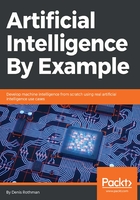
Step 3 – implementing the solution in Python
In step 1, a problem was described in natural language to be able to talk to experts and understand what was expected. In step 2, an essential mathematical bridge was built between natural language and source coding. Step 3 is the software implementation phase.
When a problem comes up—and rest assured that one always does—it will be possible to go back over the mathematical bridge with the customer or company team, and even further back to the natural language process if necessary.
This method guarantees success for any project. The code in this chapter is in Python 3.6. It is a reinforcement learning program using the Q function with the following reward matrix:
import numpy as ql
R = ql.matrix([ [0,0,0,0,1,0],
[0,0,0,1,0,1],
[0,0,100,1,0,0],
[0,1,1,0,1,0],
[1,0,0,1,0,0],
[0,1,0,0,0,0] ])
Q = ql.matrix(ql.zeros([6,6]))
gamma = 0.8
R is the reward matrix described in the mathematical analysis.
Q inherits the same structure as R, but all values are set to 0 since this is a learning matrix. It will progressively contain the results of the decision process. The gamma variable is a double reminder that the system is learning and that its decisions have only an 80% chance of being correct each time. As the following code shows, the system explores the possible actions during the process.
agent_s_state = 1
# The possible "a" actions when the agent is in a given state
def possible_actions(state):
current_state_row = R[state,]
possible_act = ql.where(current_state_row >0)[1]
return possible_act
# Get available actions in the current state
PossibleAction = possible_actions(agent_s_state)
The agent starts in state 1, for example. You can start wherever you want because it's a random process. Note that only values > 0 are taken into account. They represent the possible moves (decisions).
The current state goes through an analysis process to find possible actions (next possible states). You will note that there is no algorithm in the traditional sense with many rules. It's a pure random calculation, as the following random.choice function shows.
def ActionChoice(available_actions_range):
next_action = int(ql.random.choice(PossibleAction,1))
return next_action
# Sample next action to be performed
action = ActionChoice(PossibleAction)
Now comes the core of the system containing Bellman's equation, translated into the following source code:
def reward(current_state, action, gamma):
Max_State = ql.where(Q[action,] == ql.max(Q[action,]))[1]
if Max_State.shape[0] > 1:
Max_State = int(ql.random.choice(Max_State, size = 1))
else:
Max_State = int(Max_State)
MaxValue = Q[action, Max_State]
# Q function
Q[current_state, action] = R[current_state, action] + gamma * MaxValue
# Rewarding Q matrix
reward(agent_s_state,action,gamma)
You can see that the agent looks for the maximum value of the next possible state chosen at random.
The best way to understand this is to run the program in your Python environment and print() the intermediate values. I suggest that you open a spreadsheet and note the values. It will give you a clear view of the process.
The last part is simply about running the learning process 50,000 times, just to be sure that the system learns everything there is to find. During each iteration, the agent will detect its present state, choose a course of action, and update the Q function matrix:
for i in range(50000):
current_state = ql.random.randint(0, int(Q.shape[0]))
PossibleAction = possible_actions(current_state)
action = ActionChoice(PossibleAction)
reward(current_state,action,gamma)
# Displaying Q before the norm of Q phase
print("Q :")
print(Q)
# Norm of Q
print("Normed Q :")
print(Q/ql.max(Q)*100)
After the process is repeated and until the learning process is over, the program will print the result in Q and the normed result. The normed result is the process of piding all values by the sum of the values found. The result comes out as a normed percentage.
View the Python program at https://github.com/PacktPublishing/Artificial-Intelligence-By-Example/blob/master/Chapter01/MDP.py.